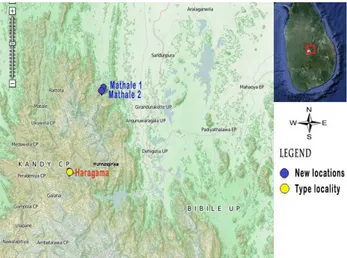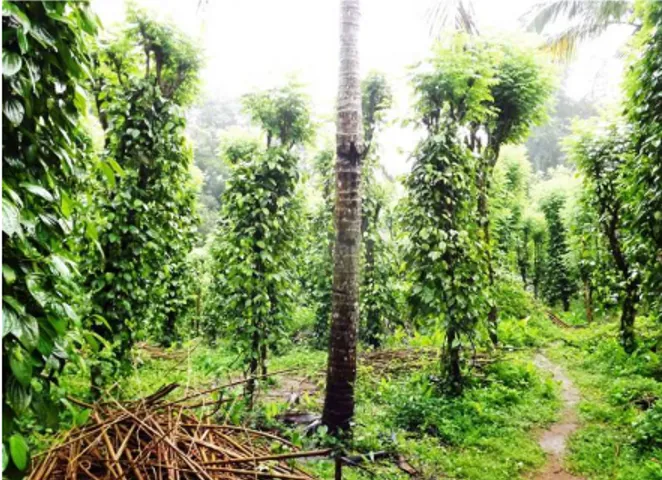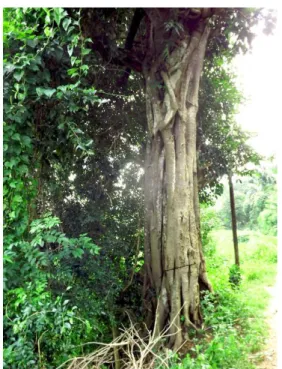The Range Extension of the Critically Endangered,
Poecilotheria smithi
in Sri Lanka, with Notes on its Sociality
Ranil P. Nanayakkara1, Nilantha Vishvanath1, 2, T. G. Tharaka Kusuminda1, 3,* and G.A.S.M. Ganehiarachchi4
1
Biodiversity Education and Research, No. 4, E. W. Adikaram Mawatha, Pita- kotte, Sri Lanka
2 Young Biologists’ Association of Sri Lanka, National Museum of Natural History, Sir Marcus Fernando Mawatha,
Colombo 7, Sri Lanka
3Department of Export Agriculture, Faculty of Agricultural Sciences, Sabaragamuwa University of Sri Lanka,
Belihu-loya, Sri Lanka
4
Department of Zoology, University of Kelaniya, Kelaniya, Sri Lanka
(Accepted May 15, 2013)
Poecilotheria smithi is a Critically Endangered Theraposid known only from the type locality Haragama in the
Kandy District, Sri Lanka. It was thought to be distribution specific to Haragama. During a survey on the genus
Poecilotheria, which was initiated in 2011 by the authors, P. smithi was recorded, the first confirmed observation
of P. smithi outside of its type locality from the Matale district about 31.42 Km in aerial distance northwest of the
type locality. Distribution of this species extended in Sri Lanka by this novel record. P. smithi displays the social
behaviour of sharing same microhabitat with few individuals. As demonstrated for P. smithi, we suggest the large
group size and social behaviour observed was in response to unavailability of suitable micro habitat for the mature individuals.
Key words: Tiger Spiders, Matale, Type locality, Tree hollow, Distribution, Social behaviour
INTRODUCTION
Distribution limits for Poecilotheria in Sri Lanka re-mains relatively poorly known because only widely scattered sites have been subjected to through surveys. This fact is underscored by the high pace of discovery of new taxa and new distributional records by arach-nologist in Sri Lanka (Benjamin et al., 2012; Nanayak-kara et al., 2012a, Nanayakkara et al., 2012b). Gaps in our distributional knowledge for majority of species of Spiders are exacerbated by the difficulty in accessing appropriate habitats, which are often fragmented and widely dispersed across rugged landscapes.
Poecilotheria smithi is a highly threatened Theraposid known only from the type locality Haragama in the Kandy District. It was thought to be distribution specific to Haragama. Surprisingly few records have been reported since it’s description by Kirk in 1996. Though several studies were under taken on the genus and on the species itself between 2002-2005, it did not yield any specimens of P. smithi. How-ever, in April 2005 a single freshly moulted female was discovered in Haragama (Gabriel et al., 2005), further two adult females and four Spiderlings were observed in July 2005 (Gabriel et al., 2005) from the type local-ity. Subsequently, a study in 2005 on the island wide distribution of the genus, did not record any specimens of P. smithi (Samarawickrama et al., 2005).
P. smithi is categorized as Critically Endan-gered by MOE (2012), due to it being endemic to Sri Lanka, intrinsically low population density, narrow estimated niche breath and its distribution specific type locality. Further, the Haragama forest is severely im-pacted by several anthropogenic factors, which combine
to cause severe habitat loss and prevent of forest regen-eration. P. smithi is generally considered solitary, and only encountered in numbers when the female is met with spiderlings. However, anecdotal reports state that sighting of up to five mature individual, using the same tree is not uncommon. Additionally, there are no known reports of Poecilotheria group composition.
Here the authors present the first documented record of P. smithi, outside its type locality (Haragama), with information on habits and social behaviour.
OBSERVATION
The observation was made during an Island wide survey on the genus Poecilotheria, which was initiated in 2011.
*Corresponding Author’s E-mail: t.kusuminda@gmail.com 73
Asian Journal of Conservation Biology, July 2013. Vol. 2 No. 1, pp. 73–75 AJCB: SC0006 ISSN 2278-7666 ©TCRP 2013
The nominated species was observed on 25th of January 2013, a female specimen was observed on a fig tree (Ficus sp.) about 31.42 km (aerial distance) northwest of the current distribution in the Matale district (Figure 1). Further, a colony of adults and sub adults were ob-served in hollow of a coconut tree (Cocos nusifera) and several other individuals were observed in a fig tree (Ficus sp.) within a radius of 5 km from the new re-corded site. The female was first observed at 2000 hrs and remained near the entrance of the hollow until 2115 hrs, when it move a little away from the hollow, and stayed there (Figure 2). However, when it was disturbed it quickly retreated into the hollow and remained there. The main activity was the movement to and from the tree hollow. With the other individuals recorded, no aggression was recorded; feeding, movement to and from the hollow, in all individuals. The juveniles were considerably more active than adults.
P. smithi is clearly set apart from the conge-ners by the coxa, trochanter and femur being velvety black with a very thin white band on the distal edge of the femur and also the patella of P. smithi is mostly white with a thick distal black band (Figure 3). The observation occurred in a Coconut tree situated in heav-ily disturbed Pepper cultivation (Piper nigrum) (Figure 4) and a fig tree adjoining a paddy field (Oryza sativa) (Figure 5). The area is heavily used by local villagers, as the fig tree boards a forest footpath.
Figure 2. Poecilotheria smithi in its natural Micro-habitat.
This record represents the first confirmed ob-servation of P. smithi outside its type locality and ex-tends the reported distribution of the species in Sri Lanka. Distribution is extending to the new point, indi-cating a wider island-wide distribution of P. smithi in Sri Lanka than hitherto assumed. There are several ad-ditional areas of comparable forest within this potential distribution also connected with the central hill country that represent potential habitat for this species. Several of these potentially suitable areas fall under protected area, thus conservation measures can be put in place
for the species. But the major challenge will be to
establish the extent of continuity of its distribution be-tween these geographically scattered records. Hence, Ad-ditional surveys are suggested to document the specie’s geographic distribution and abundance, evaluate conserva-tion status, and improve our understanding of its ecologi-cal and social behaviour.
Figure 3. Ventral aspect of Poecilotheria smithi.
There has been very little documented evidence on the social behavior of the genus Poecilotheria, both in India and Sri Lanka. As demonstrated for P. smithi, we suggest the large group size and social behaviour observed was in response to unavailability of suitable micro habitat for the individuals, as these species prefer old well estab-lished trees with naturally occurring hollows etc. How-ever, the spiderlings found with the female is the norm, as this behavior has been recorded from the congeners. Little is known about the effects of timber harvesting and agri-culture production or human disturbance on the population of the new record. However, these have to be further ana-lyzed to get an understanding of conservation need to be implemented for the furtherance of the species.
Figure 4. Coconut tree situated in heavily disturbed Pep-per cultivation.
Moreover, the high demand for this rare species
in the international pet trade could affect the population,
Nanayakkara et al.
as the illegal over harvesting could have dire conse-quence for the species as a whole. As such, stringent measure must be taken to curb, the illegal collecting of this species from the wild. As it has been highlighted for other species of Poecilotheria both in India and Sri Lanka. Necessary measure must be taken to educate local villagers and law enforcement officers, of the im-portance and identification of these endangered species.
CONCLUSION
In summary, the observations reported here suggest that much more survey work is required to understand the conservation status of Poecilotheria and its habitat pref-erence. These species tend to have peculiar habitat re-quirements that increase their potential susceptibility to climate change and habitat destruction.
ACKNOWLEDGEMENTS
We would like to thank Department of Wildlife Conser-vation in Sri Lanka for providing permits to work in protected forest areas, Biodiversity Secretariat (BDS) of Ministry of Environment, Sri Lanka for financial support, and Ms. Hasula Wickramasinghe for kind co-ordination between BDS and us, Mr. Jayan Sri Jeewan-tha in guidance for preparing maps and Mr. Gamini for his tireless field guidance.
REFERENCES
Benjamin, S. P., Nanayakkara, R. P., and Dayananda, S. K. (2012). The Taxonomy and Conservation Status of the Spiders (Arachnida: Araneae) in Sri Lanka. In: The National Red List 2012 of Sri Lanka; Conservation Status of the Fauna and Flora. Weerakoon, D.K. & S. Wijesundara Eds., Ministry of Environment. Colombo Sri Lanka. 42-45pp.
Gabriel, R., Pedersen, N., and Rafn, S. (2005).Notes and Observations of Poecilotheria smithi and theThreat to its Survival in Captivity and Sri Lanka, Journal of the British Tarantula Society, 21 (1), 4-8.
Kirk, P. J. (1996). A new species of Poecilotheria
(Araneae: Theraphosidae) from Sri Lanka.
Journal of British Tarantula Society 12 (1), 20-30.
MOE (2012). The National Red List 2012 of Sri Lanka; Conservation Status of the Fauna
and Flora. Ministry of Environment, Colombo, Sri Lanka.viii + 476pp.
Nanayakkara, R. and Vishvanath, N. (2011). Hitherto unrecorded species of Poecilotheria (Tarantula) from Sri Lanka. National Science Foundation E-j o u r n a l . (h t t p : / / w w w. n sf . a c . l k / n e wl e t t e r/ VOL2NO7/tarantula.pdf)
Nanayakkara, R. P., Ganehiarachchi, G.A.S.M., Vishvanath, N. and Kusuminda, T.G.T. (2012a). Current Distribution of Tiger Spiders (Genus:
Poecilotheria), in Selected Sites in Sri Lanka. Proceedings of 13th Annual Research Symposium, “The Multi-faceted Nature of Research in the 21st Century” Multidisciplinary
Symposium Conducted by the Faculty of Graduate Studies (FGS), University of Kelaniya, Sri Lanka, November 22 & 23 2012. 101pp. Nanayakkara, R. P., Kirk, P. J., Dayananda, S. K.,
Ganehiarachchi, G.A.S.M., Vishvanath, N. and Kusuminda, T.G.T. (2012b). A New Species of Tiger Spider, Genus Poecilotheria, From Northern Sri Lanka. British Tarantula Society Journal 28(1): 6-15.
Samarawickrama, V. A. M. P. K., Janananda, M. D. B. G., Ranawana, K. B., and Smith, A. (2005). Study of the distribution of the genus Poecilotheria of the family Theraphosidae in Sri Lanka, Ceylon Journal of Science, (Bio. Sci.), Vol. 34, pp 75-86. Smith, A. and Kirk, P. (2002). A Field Guide On The Theraphosid Spiders Of Indian & Sri Lanka, particularly the genus Poecilotheria.
Range extension of Poecilotheria smithi in Sri Lanka
AJCB Vol. 2 No. 1, pp. 73 -75, 2013 75


